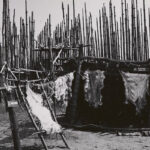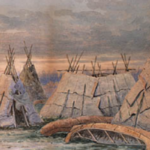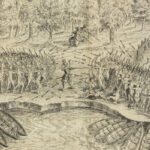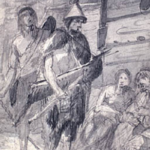Pabineau First Nation: Custodians of the Nepisiguit River
The Pabineau First Nation, located along the banks of the Nepisiguit River near Bathurst, New Brunswick, represents a proud and enduring community within the Mi’kmaq Nation. Steeped in history, the story of the Pabineau people is one of resilience, adaptation, and a profound connection to their ancestral lands. From their pre-contact roots through their first interactions with European explorers to the challenges and opportunities of the modern era, the journey of the Pabineau First Nation reflects their ability to sustain and honour their traditions while embracing change.
Pre-History: Mi’kmaq Origins and Connection to the Land
The Mi’kmaq, one of the Indigenous peoples of northeastern North America, trace their ancestry back over 10,000 years. Archaeological findings, including ancient tools, fishing weirs, and ceremonial artifacts, reveal a deep and continuous presence in the lands that now comprise the Atlantic provinces. The Nepisiguit River, with its abundant fish stocks and access to the Gulf of St. Lawrence, played a central role in the lives of the Pabineau people, providing food, transportation, and spiritual inspiration.
The Mi’kmaq of the Pabineau area followed a seasonal cycle of movement, spending summers along the river to fish for salmon and eels, while winters brought smaller family groups inland to hunt moose, caribou, and smaller game. Their environment was not merely a backdrop to their lives but an integral part of their worldview. Guided by the principle of Netukulimk, the Mi’kmaq harvested resources sustainably, ensuring that the bounty of the land and water would endure for future generations.
Their spiritual beliefs were deeply connected to the natural world. Rivers, forests, and animals were seen as living entities imbued with spirit and agency. Ceremonial practices, including offerings and dances, expressed gratitude for the gifts of the earth and maintained the balance between humanity and nature.
Governance and Social Structure
The governance of the Mi’kmaq, including the Pabineau community, was decentralized and consensus-based. Each community was led by a Sagamore (chief), who was chosen for their wisdom, leadership abilities, and ability to mediate disputes. These leaders, supported by councils of elders, guided decisions on hunting territories, trade relationships, and conflict resolution.
The Mi’kmaq were part of the larger Wabanaki Confederacy, an alliance of Algonquian-speaking nations that included the Passamaquoddy, Penobscot, Maliseet, and Abenaki. This confederacy provided mutual support and shared governance, ensuring peace and collaboration among the peoples of the northeast.
First Contact with European Explorers
The arrival of European explorers in the 16th century marked a significant turning point for the Mi’kmaq, including the Pabineau community. Early interactions were primarily with Basque, Breton, and Norman fishermen, who frequented the Gulf of St. Lawrence and nearby rivers for the region’s rich cod fisheries. These encounters were often transactional, with the Mi’kmaq trading furs for European goods such as metal tools, cloth, and beads.
The establishment of French settlements in the 17th century deepened these interactions. French explorers, including Samuel de Champlain, recognized the Mi’kmaq’s expertise in navigating and surviving the land. The Mi’kmaq of Pabineau became important partners in the burgeoning fur trade, supplying beaver pelts and other furs to French traders.
While these relationships brought material benefits, they also introduced challenges. Overharvesting of fur-bearing animals disrupted traditional hunting practices, and the arrival of Europeans brought diseases such as smallpox and measles, which decimated Indigenous populations. Despite these hardships, the Mi’kmaq adapted, incorporating European tools into their way of life while maintaining their cultural identity.
Relationships with Missionaries and Settlers
The 17th and 18th centuries saw the arrival of Catholic missionaries, particularly Jesuits, who sought to convert the Mi’kmaq to Christianity. Missions established along the Nepisiguit and nearby rivers became focal points for cultural exchange and spiritual transformation. Many Mi’kmaq adopted aspects of Christianity, blending it with their traditional beliefs in a syncretic fashion that allowed them to preserve core elements of their worldview.
The Pabineau community, like other Mi’kmaq groups, allied with the French during conflicts with the British, including the Seven Years’ War (1756–1763). These alliances were rooted in mutual benefit, as the French provided goods and military support while the Mi’kmaq offered their knowledge of the land and waterways.
Following the British victory in 1763, the dynamics of these relationships changed. British policies often ignored Indigenous sovereignty, leading to encroachments on Mi’kmaq lands and resources. The establishment of settler communities in the Bathurst area further limited access to traditional hunting and fishing grounds.
The 19th and 20th Centuries: Adaptation and Resilience
The 19th century brought increasing pressures on the Pabineau First Nation as industrial development encroached on their traditional lands. Logging along the Nepisiguit River disrupted fish habitats, while farming and settlement reduced the availability of hunting and gathering grounds. The imposition of the Indian Act (1876) confined the Mi’kmaq to reserves, restricting their mobility and governance systems.
Despite these challenges, the Pabineau First Nation adapted. Many community members became involved in the logging industry, using their knowledge of the forests and rivers to work as guides, loggers, and canoe builders. Traditional crafts such as basket-making and beadwork also provided both economic support and a means of preserving cultural practices.
During this period, the community faced significant cultural disruption, particularly through the residential school system, which sought to assimilate Indigenous children by severing their ties to their language and heritage. Nevertheless, the Pabineau people maintained their identity through oral traditions, seasonal practices, and a deep connection to the land.
Cultural Revitalization and Environmental Stewardship
In recent decades, the Pabineau First Nation has undertaken significant efforts to revitalize their culture and preserve their environment. Language programs aim to ensure the survival of Mi’kmawi’simk, the Mi’kmaq language, while cultural workshops and events celebrate traditional practices such as drumming, storytelling, and crafting.
The annual Pabineau Powwow serves as a gathering for the community and an opportunity to share their heritage with others. This event, featuring traditional dances, songs, and ceremonies, reflects the pride and resilience of the Pabineau people.
Environmental stewardship remains a central focus of the community. The Nepisiguit River, once a vital source of sustenance, has been the subject of restoration efforts aimed at improving water quality and restoring salmon populations. These initiatives reflect the Pabineau First Nation’s commitment to protecting their ancestral lands for future generations.
Pabineau Today: A Thriving Community
Today, the Pabineau First Nation is a dynamic and forward-looking community that balances economic development with cultural preservation. Investments in infrastructure, education, and healthcare reflect their commitment to creating opportunities for future generations while honouring their traditions. The community’s focus on eco-tourism, including guided tours and cultural experiences, has helped showcase their rich heritage to a broader audience.
The Pabineau First Nation also plays a leadership role in regional governance, advocating for Mi’kmaq rights and environmental sustainability. Their efforts highlight the enduring strength of their people and their ability to adapt while maintaining their identity.
Conclusion: A Legacy of Strength and Continuity
The history of the Pabineau First Nation is a testament to their resilience, adaptability, and deep connection to the land and waters of the Nepisiguit River. From their ancient presence in the region to their central role in early European trade and their modern efforts in cultural revitalization and environmental advocacy, the Mi’kmaq of Pabineau have maintained their identity and place within Canada’s evolving landscape.
As an elder from Pabineau once said, “The river is our teacher, our lifeline, and our memory. By honouring it and our traditions, we ensure that our story continues.”
References
- Whitehead, Ruth Holmes. The Old Man Told Us: Excerpts from Micmac History, 1500–1950. Nimbus Publishing, 1991.
- Brightman, Robert. Grateful Prey: Rock Cree Human-Animal Relationships. University of California Press, 1993.
- Jesuit Relations. Documents of the Missions to New France. McGill University Press, 1962.
- Pabineau Cultural Centre. Guardians of the Nepisiguit: The History and Culture of Pabineau First Nation. Pabineau Publications, 2016.
- Conrad, Margaret. A Concise History of Canada. Cambridge University Press, 2012.
- Environmental Justice Advocacy Group. Stewardship and Sovereignty: The Role of the Mi’kmaq in Environmental Advocacy. University of Guelph Press, 2019.
- Mi’kmaq Grand Council. Santé Mawiómi: Traditions and Governance of the Mi’kmaq Nation. Halifax Press, 1985.
- Ridington, Robin. Trail to Heaven: Knowledge and Narrative in a Northern Native Community. Douglas & McIntyre, 1988.
- Johnston, Basil. Ojibway Heritage. McClelland & Stewart, 1976.
- Snow, Dean R. The Iroquois. Blackwell, 1994.



